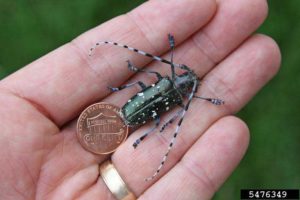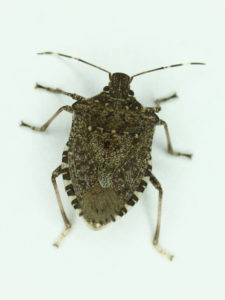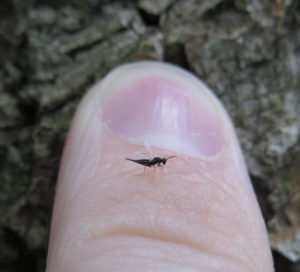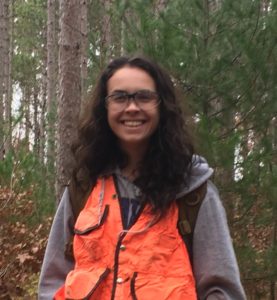The National Park Service, Department of Health and Human Services and the Center for Disease Control came together to create the “Parks, Trails, and Health Workbook,” a quick guide and outline for incorporating public health considerations in the development of a park or trail. Utilizing the health impacts of these natural areas is a different and critically important way to promote parks and trails. Applying health benefits provides a personal connection and increased relevance to community members and encourages them to act and get outdoors. Continue reading “A tool to integrate public health considerations in the development of parks and trails”
Archives
Tree inventory on Western Technical College campus
Inventorying trees can be a tedious process, though it is an important one. You look up at individual trees, but then you look back on a forest.
Tree inventories are foundational parts of any urban forest program. That was the underlying message of the recent visit of DNR staff to Western Technical College in La Crosse where, at the invitation of landscape horticulture instructor David Lein, the DNR provided an introduction to tree inventories. Continue reading “Tree inventory on Western Technical College campus”
Phillips High continues evaluating community trees
Phillips High School students are showing the value of trees in their community. For the past three years the students have been inventorying the trees in the community. Over those years the project has continued to grow each year, from collecting data on trees to identifying planting sites, and now building community awareness by putting price tags on trees. Continue reading “Phillips High continues evaluating community trees”
Bay-Lake RPC announces the award of 20 tree grants
Three Wisconsin regional planning commissions and the Wisconsin Department of Natural Resources (DNR) have jointly awarded $122,000 in grants to communities under their 2018/19 Wisconsin Regional Planning Commissions (RPCs) and DNR Great Lakes Basin Tree Planting Grant Program. Twenty Wisconsin communities will receive funds for projects to reduce runoff and mitigate the impacts of Emerald Ash Borer (EAB). The grant funds are supporting the planting of nearly 1,000 trees throughout the Wisconsin Great Lakes Basin to help reduce runoff and recover from canopy losses from EAB. Continue reading “Bay-Lake RPC announces the award of 20 tree grants”
Tree canopy cover benefits assessed using i-Tree Landscape
Imagine that you waved a wand across your community and pollutants from hundreds of tail pipes and smoke stacks disappeared. Far-fetched, no? But that is what trees do every day, and a new tool could summarize some of the magic trees are performing to improve public health and infrastructure. Continue reading “Tree canopy cover benefits assessed using i-Tree Landscape”
Pesticide applicator training offered in 2019
By Kyoko Scanlon, forest pathologist, Fitchburg, Kyoko.Scanlon@Wisconsin.gov, 608-235-7532
Wisconsin Pesticide Applicator Training (PAT) Program with University of Wisconsin Extension is offering one training session for Forestry (Category 2.0) in 2019. The training is a one-day indoor session to review the materials in the training manual. A certification exam will be administered at the end of the day by Wisconsin Department of Agriculture, Trade and Consumer Protection.
The PAT Forestry training day is scheduled for January 24, 2019 at the Marathon County Extension Office in Wausau. Preregistration is required and costs $30. For more information and to register, visit the Pesticide Applicator Training website.
ALB: What to watch for in Wisconsin
By Linda Williams, forest health specialist, Woodruff, Linda.Williams@wisconsin.gov, 920-360-0665
We do NOT have Asian longhorned beetle (ALB) in Wisconsin at this time, but it’s good to be on the lookout for it. Every year folks submit reports of insects that they suspect to be ALB, but to date they have always been confirmed as the native whitespotted sawyer (sometimes called pine sawyer), which attacks stressed conifers rather than the maple and other hardwood species preferred by ALB. If you find a beetle that you suspect to be ALB, please collect the beetle, take some pictures, and send them to your forest health specialist, or to the University of Wisconsin Insect Diagnostic Lab for identification.

Asian longhorned beetle is a large beetle. They are smooth and shiny black with white spots and blotches on their wing covers. Photo by Joe Boggs, Ohio State University, bugwood.org.

Our native pine sawyer beetle appears dusty or pitted, but is often mistaken for Asian longhorned beetle. Photo by Linda Williams.
ALB can be a very destructive pest. It is typically introduced, unintentionally, to new areas via wooden pallets, wood packing materials, or firewood. The Don’t Move Firewood website has some great tips for safe transport of firewood, how to find firewood locally, as well as a list of other invasive insects and diseases to be aware of when buying or using firewood.
USDA APHIS, which conducts eradication efforts wherever ALB is found, recently announced that an area of Ohio was officially ALB-free, and the quarantine was subsequently removed. Earlier this year in March, a separate area of Ohio was also declared ALB-free. That leaves just one area of Ohio with ALB quarantines still in effect. Eradication of ALB can take decades to complete and involves extensive efforts including tree removal and chemical treatments. States with current ALB quarantines include: Massachusetts, New York and Ohio.
For more info on ALB, check out the USDA APHIS ALB webpage, and as always, please let us know if you think you have come across a forest health concern, including ALB.
Invasive stink bug numbers increasing
By Mike Hillstrom, forest health specialist, Fitchburg. Michael.Hillstrom@wisconsin.gov; 608-513-7690
Invasive brown marmorated stink bugs (BMSB) are now well established and reproducing in southern and central Wisconsin. This fall we are getting our first reports of large numbers of BMSB gathering on the sides of houses looking for places to overwinter. This problem will continue to get worse as stink bug populations increase and their range expands. Damage to important crops, ornamental plants and trees will also be a major concern. BMSB is known to feed on a wide variety of plants including apples, tomatoes, corn, soybeans, silver maple and walnut.

An adult brown marmorated stink bug. Photo by P.J. Liesch, University of Wisconsin Insect Diagnostic Lab.
Researchers are working on ways to manage the pesky bugs. One new method being explored is hanging black netting soaked in insecticide at locations where the bugs congregate, such as doors on the north and east sides of structures.
Samurai wasps are another promising lead. These stink bug-killing wasps found their way into the U.S. on their own over the past few years, but researchers are also working with lab-reared samurai wasps that they hope to release. Samurai wasps parasitize the eggs of BMSB but do not sting humans or other animals.
For more information about identification and management check out:
• University of Wisconsin-Extension
• WisContext
• Midwest Stink Bug app
EAB biological control recoveries
By Bill McNee, forest health specialist, Oshkosh. bill.mcnee@wisconsin.gov; 920-360-0942
Tetrastichus planipennisi, an introduced, parasitic wasp that attacks emerald ash borer (EAB) larvae, was successfully recovered at two sites in Racine and Waukesha counties in October 2018. This was the first recovery of the natural enemy from Waukesha County. These events indicate that the wasps, released at the same sites in 2015, successfully established and have been attacking EAB larvae since then. This wasp species was previously recovered at release sites in six southeast Wisconsin counties (Kenosha, Milwaukee, Ozaukee, Racine, Walworth and Washington). These releases began in 2011 to reduce EAB populations over the long term, so that some small ash trees might reach reproductive maturity, thus allowing ash to persist on the landscape, albeit as a smaller, less common tree. The tiny wasps do not sting or bite people, and the public is unlikely to ever see them.

Adult Tetrastichus planipennisi wasp shown on a finger. Photo by Bill McNee.
Tree bark samples from the two sites are currently being incubated to look for another parasitic wasp, Oobius agrili, that may be present in EAB eggs. This species has not been recovered in prior surveys and is known to be more difficult to detect than T. planipennisi. Recovery surveys will continue at many locations 2-3 years after wasps are released to allow the populations of introduced parasitoids to increase to detectable levels.
It is important to note that insecticide treatment of high-value ornamental trees still needs to be done to prevent tree mortality from EAB. For more information about EAB, parasitoid wasps, and insecticide treatments, visit http://www.emeraldashborer.wi.gov.

Cluster of Tetrastichus pupae (circled) from a parasitized EAB larva, located near an unparasitized EAB larva. Photo by Bill McNee in Racine County, October 2018.
New forest health specialist for Central Zone

New forest health specialist Alex Feltmeyer. Photo by Mike Hillstrom.
Alexandra (Alex) Feltmeyer started October 15, 2018 as the Forest Health Specialist for the Central Zone (Adams, Green Lake, Lincoln, Marathon, Marquette, Menominee, Oconto, Portage, Shawano, Taylor, Waupaca, Waushara, and Wood counties). Alex will be stationed at the Plover Ranger Station and will start making connections with the foresters and partners in her zone right away. Her contact information is Alexandra.Feltmeyer@wisconsin.gov and 715-340-3810.
As a reminder, the DNR forest health specialists are available to diagnose and provide management recommendations for forest health concerns such as insect, disease and weather-related damage on forested properties in Wisconsin. The forest health specialists are also available to give presentations and trainings on current insect and disease concerns and management guidelines. For a full list of forest health program staff and the counties they cover, please visit https://dnr.wi.gov/topic/ForestHealth.
